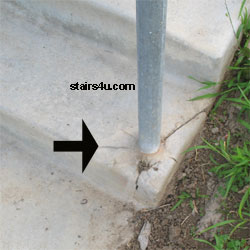Seasonal Movement - Building Materials And Weather
Seasonal movement is usually caused from the expansion
and contraction of building materials. The example below provides you
with a metal handrailing pole that was placed near the edge of a
concrete stairway.
The cracks around the pole are probably related to
the expansion and contraction of the concrete, around a metal pole. I'm
using the word probably (refer back to last sentence) for the cracks,
because there are a few other things that could cause something like
this to happen.

How Does A Concrete Stairway Expand Or Contract?
It's all relevant to the amount of moisture or heat in the area. If
there is a lot of moisture in the ground and the stairway is located in
an area where it rains often, the concrete will absorb the moisture and
expand.
Don't forget that heat will also cause concrete to expand and once the
temperatures have stabilized, the concrete will contract. Concrete
cracks are caused from the expansion and contraction of concrete.
Concrete Sidewalk Seasonal Movement Problems
One-time me and my wife were going to eat breakfast one morning at one
of our favorite cafés.
We looked over at the sidewalk that we usually stepped over, as we made
our way to the café, only to realize that two 6 foot sections of
concrete had raised about 24 inches off of the ground.
I don't know if the city ever made any repairs to the sidewalk or if it
shrank back on its own, to its original shape, but it looks normal
again.
Hard to imagine, but if anyone tells you that concrete doesn't move, I
would love to hear an explanation for this one particular event.
Stairs / Stair Glossary
A B C D E F G H I J K L M N O P Q R S T U V W X Y Z


